I have never felt so much like a foreigner in my own country as I did in Honolulu. Well, maybe one time in The Bronx. The natives are Polynesian and tourists (busloads of them) are Japanese and Chinese. You can always tell the Japanese from the Chinese, because the Japanese have a sense of style. The Chinese wear black socks and sandals.
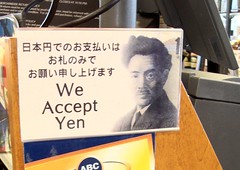
While I’m on the subject of the Japanese, let me tell you about our visit to Pearl Harbor. My wife had arranged for us to be picked up at the hotel by a tour bus. The bus was driven by a big, good-natured guy named Oran who delivered an informative commentary throughout the drive.
On the way, we stopped at the Punchbowl Crater, a perfect bowl-shaped crater that is lush and green. It is the location of the National Memorial Cemetery of the Pacific. Tens of thousands of soldiers are buried there, veterans of World War I, World War II, Korea and Vietnam. There are a few noteworthy Hawaiian politicians buried there, and strangely, two local celebrities: Donn Beach, the creator of the tiki bar and Norman Collins, a well-known Honolulu tattoo artist.
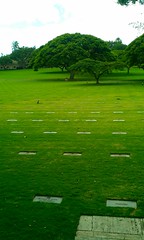
The memorial is understated and peaceful, inscribed with this quote from a letter written by Abraham Lincoln to a grieving mother who lost five sons in the American Civil War:
“The solemn pride that must be yours to have laid so costly a sacrifice upon the altar of Freedom.”
Damn, that son of a bitch could write.
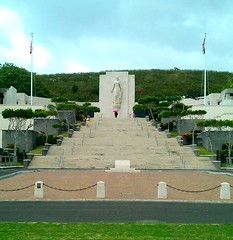
On the flanks of Punchbowl Crater is a land-grant Hawaiian community. If you are at least 50% native Hawaiian, you can apply for a 100-year lease at a cost of $1 per year. Oran informed us that the waiting list is generations long.
We continued on to Pearl Harbor, eventually arriving at the World War II Valor in the Pacific National Monument. It’s a collection of small museums and exhibits, which includes the USS Arizona.

Nearby is a World War II submarine exhibit (USS Bowfin) and the last commissioned battleship in the American Navy, the USS Missouri (Mighty Mo), on whose decks the unconditional surrender of the Japanese in World War II was accepted by General Douglas MacArthur.
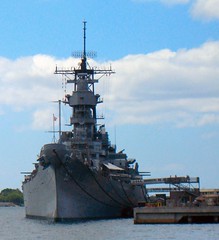
Inside the museums are lots of fascinating exhibits, like this model of the Japanese aircraft carrier Akagi, decks loaded with zeroes. The tower rising above the deck is clad in rolled-up mattresses to protect the officers and crew from shrapnel.
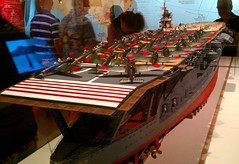
There is also a model of the USS Arizona. The detail is incredible:
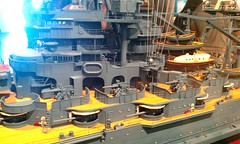
Pearl Harbor is only about 35 feet deep, shallow by most standards. The Japanese had to modify the torpedoes dropped by aircraft so that they wouldn't strike the harbor bottom and explode prematurely. Here’s one that was destroyed on impact:

Also on display are some artifacts recovered from the USS Arizona, including an anchor and the ship’s bell.

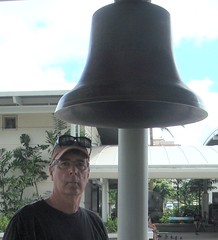
The National Monument (including the Arizona Memorial) are operated by the National Park Service, but the US Navy operates the watercraft that shuttle visitors to the Memorial. Before you can board a shuttle, you have to watch a brief film describing the events that resulted in the devastating surprise attack that crippled the American Pacific fleet. The film is shown with English subtitles for the hearing-impaired, but for some unknown reason, it is not shown with Japanese subtitles for the benefit of the large number of Japanese tourists.
For those of you who may not know, the USS Arizona was sunk at anchor in Pearl Harbor during the Japanese attack on December 7, 1941. A bomb struck the forward munitions hold, killing 1,177 sailors and marines from the concussion of the resulting explosion. The bodies of those sunk in the wreckage have been left in place, since the effort to retrieve them would have been too dangerous.
The USS Arizona Memorial straddles the bridge of the sunken ship. Here is a model of the memorial:
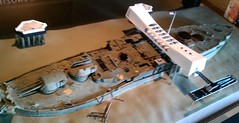
As we approached the memorial, I noticed several additional modest memorials to the other ships sunk on Battleship Row during the attack that day.
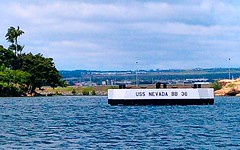
The memorial itself is austere and serene, its spare design clearly subordinate to the complex historical events that led to the overwhelming tragedy of the wreckage beneath it.
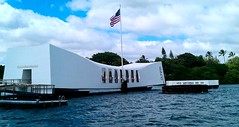

Very little of the superstructure remains above water. This is one of the massive rotating gun turret mounts.
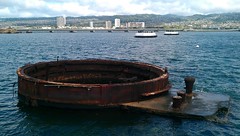
And this is broken end of the ship’s mast. The flagpole that stands above the memorial is attached to it.

Inside the memorial there is a port through which you can see the shadowy outlines of the deck, now host to schools of fish.

On the other side of the memorial, the deck is clearly visible.

Fuel oil still leaks from the ship, over 70 years after it sank. It is feared that enough oil remains to cause a serious environmental hazard if the tanks should rust through. But officials are reluctant to try and drain the oil for fear of disturbing the remains of the dead.
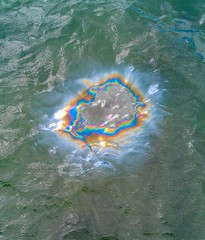
Further into the memorial is a wall commemorating the names of the dead.
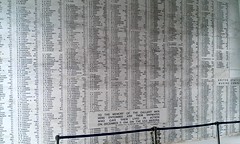
I confess that I was choked up, until I noticed this smaller wall labeled “USS Arizona survivors interred with their shipmates.” I asked a park ranger what it meant.
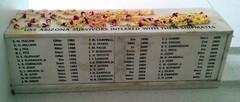
A small number of crew members survived the attack. They have lived with the horrifying memory of the disaster for the remainder of their lives. Upon their death, they may have their remains cremated and Navy divers will carry the urn to a final resting place within the hull of the Arizona. Those flowers you see on top are leis, left there every day by visitors as a token of respect and collective grief. OK that did it. I had to go somewhere and compose myself.
On the way back, the sailors piloting the shuttle allowed this young visitor to steer the boat most of the way back, giving him simple verbal directions, since he couldn’t see out of the window.
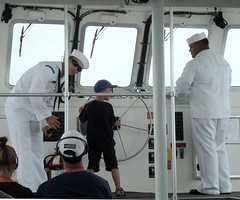























1 comment:
Amazing photography. I went there 25 years ago, and felt many of the same emotions you did, Tim. It was strange to be there with Japanese tourists, but I was reminded that it's part of their history too. It didn't stop a couple of somewhat jaded locals to comment to my wife and myself that what the Japanese didn't bomb, they bought. But this was the mid to late 1980s. Eons ago, essentially.
Kevin M.
Post a Comment